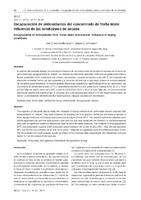Encapsulación de antioxidantes del concentrado de yerba mate : Influencia de las condiciones de secado
Encapsulation of antioxidants from yerba mate concentrate : Influence of drying conditions
Date
2019-11-04Author
Hermosilla Vera, José Osvaldo
Schmalko Radichowski, Miguel Eduardo
Metadata
Show full item recordAbstract
El objetivo del presente trabajo fue estudiar la influencia de las condiciones de secado de cápsulas de extracto de yerba mate (Ilex paraguariensis St. Hilaire). Las mismas se obtuvieron aplicando la técnica de gelificación iónica y fueron sometidas a tres condiciones de secado: microondas y secado convectivo a 60 y 80º C. Las isotermas de adsorción obtenidas fueron del tipo sigmoidal y la ecuación de GAB fue la que mejor explicó el comportamiento de los datos experimentales, no encontrándose diferencias estadísticas significativas entre los materiales. Los contenidos de polifenoles totales (CPT) y capacidad antioxidante (CAO) presentaron valores entre 20,12 y 19,68 g EAG/100g ms (masa seca) para CPT, y para la CAO entre 20,47 y 19,45 g EAA/100g ms, no encontrándose diferencias estadísticas significativas. El consumo de 5 g de cápsulas aportaría el 41% del requerimiento diario de calcio. La velocidad de rehidratación fue mayor para las cápsulas secadas con microondas. The objective of this work was to study the influence of drying conditions on yerba mate extract capsules (Ilex paraguariensis St. Hilaire). They were obtained by applying the ionic gelation technique and were subjected to three drying conditions: microwave and convective drying at 60 and 80º C. The sorption isotherms obtained were of the sigmoidal type and the GAB equation was the one that best explained the behavior of the experimental data, and no significant statistical differences were found in the three materials. The contents of total polyphenols (CPT) and antioxidant capacity (CAO) presented values between 20.12 and 19.68 g EAG / 100g DM (dry mass) for CPT, and for the CAO between 20.47 and 19.45 g EAA / 100g DM, no significant statistical differences were found. The consumption of 5 g of capsules, would contribute 41% of calcium daily requirement. The rehydration rate was higher for the microwave-dried capsules.
URI
https://hdl.handle.net/20.500.12219/2170https://doi.org/10.36995/j.recyt.2019.32.008
https://www.fceqyn.unam.edu.ar/recyt/index.php/recyt/article/view/250
Collections
The following license files are associated with this item:




